As digital threats continue to evolve, safeguarding your website is no longer an option—it is essential to your business’s success. Research shows that cyber attacks are on the rapid increase. Cybercriminals continue to develop increasingly sophisticated tactics, making website security a top priority for businesses in 2025. Protecting your digital presence requires proactive, multi-layered strategies to prevent breaches, maintain customer trust, and enhance your online reputation. Let’s explore some essential practices to protect your website from emerging cyber threats in 2025.
Implement HTTPS and SSL/TLS Encryption
Switching your website from HTTP to HTTPS is fundamental to your cybersecurity strategy. HTTPS (Hypertext Transfer Protocol Secure) combined with SSL/TLS encryption ensures secure data transfer between your server and your visitors’ browsers, significantly reducing the risk of data breaches and interception. Google and other search engines also prioritize HTTPS websites, boosting your site’s SEO performance and ranking.
Regularly Update Software and Plugins
Outdated software is one of the most common security vulnerabilities cybercriminals exploit. Regularly updating your CMS, themes, plugins, and server software addresses known vulnerabilities. These updates allow you to identify areas that need to be addressed and can also identify potential cyber security threats. If possible, implement automatic updates on any systems that allow it. This reduces the risk of human error and oversight.
Strengthen Authentication Practices
Enhancing authentication mechanisms greatly reduces unauthorized access. Multi-factor authentication (MFA) adds a layer of security, requiring individuals to verify their identity beyond their password. Complex sign-in processes, including password managers and password updates, minimize the risk of credential theft.
Utilize Web Application Firewalls (WAF)
A Web Application Firewall (WAF) is essential for proactive threat mitigation. WAFs filter incoming traffic, blocking attacks such as SQL injections, cross-site scripting (XSS), and Distributed Denial of Service (DDoS) attacks.
By continually analyzing web traffic patterns, WAFs can detect and neutralize threats before they impact your site, significantly enhancing your defense strategy.
Conduct Regular Security Audits and Penetration Testing
Proactive security audits and penetration tests identify weaknesses before attackers exploit them. Regularly scheduled assessments—performed annually or even quarterly—simulate cyberattacks to uncover vulnerabilities.
Consider collaborating with cybersecurity professionals who conduct thorough penetration tests and provide detailed recommendations for strengthening your website’s security infrastructure.
Guard Against XSS and SQL Injection Attacks
Cross-site scripting (XSS) and SQL injection attacks are two common and persistent threats. Both exploit weak points in your website’s code or database to access sensitive data.
To mitigate these attacks:
- Input Validation and Sanitization: Strictly validate and sanitize user inputs to eliminate malicious scripts.
- Parameterized Queries: Use parameterized queries or prepared statements to separate SQL code from user-provided data, effectively preventing SQL injection.
Ensure Secure Data Storage and Transmission
Data protection standards must include both stored and transmitted information. Encryption methods, such as AES-256 encryption and secure data storage, while SSL/TLS encryption secures data during transit.
Additionally, secure and regular data backup should be implemented and stored offsite or in secure cloud environments. Reliable backups facilitate faster recovery in case of an incident like ransomware attacks or data corruption.
Invest in Employee Training and Awareness
Your team plays a critical role in cybersecurity. Human error—such as falling victim to phishing emails—is among the most common causes of breaches. Regular security awareness training for employees teaches them to identify threats, handle sensitive data securely, and respond appropriately to suspicious activities.
Creating a culture of cybersecurity awareness and vigilance in your company can greatly reduce the likelihood of incidents.
Implement Continuous Monitoring and Incident Logging
Proactive monitoring enables the early detection of unauthorized activity. Implementing automated systems and security software that continuously track your website’s activity and user behavior patterns is crucial.
Detailed logs of all site activities facilitate rapid response and forensic investigation in case of an incident. Tools providing real-time alerts can further empower your security team to respond swiftly and effectively to potential threats.
Create and Maintain an Incident Response Plan
Even the best defenses sometimes fail, making an incident response plan crucial. A comprehensive response plan outlines clear, actionable steps, including roles and responsibilities, communication protocols, containment procedures, and recovery actions.
Ensure regular review and updates of this plan, accounting for evolving threats and business changes. Periodic drills will prepare your team for rapid, coordinated responses, minimizing potential damage and downtime.
Stay Informed About Emerging Cybersecurity Trends
Cybersecurity threats constantly evolve, making awareness critical. For example, though cybercrime is on the rise, ransomware payment is on the decline. To stay current, businesses should engage with cybersecurity news and communities to ensure safety.
As long as the internet exists, cyber threats will be an issue. Luckily, businesses can proactively protect themselves and their customers from these threats.
Partner with Experts for Better SEO Results
Effect Web Agency specializes in web design and digital marketing, including advanced SEO optimization and Google Analytics integration. Our team can help you set up, interpret, and act on analytics data to enhance your SEO efforts.
Ready to unlock the full potential of your SEO strategy? Contact Effect Web Agency today and let us help you turn insights into measurable results.



